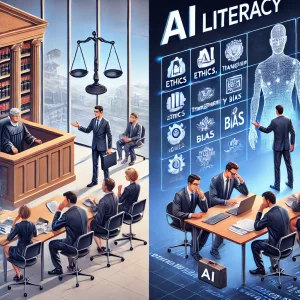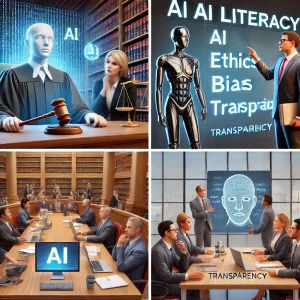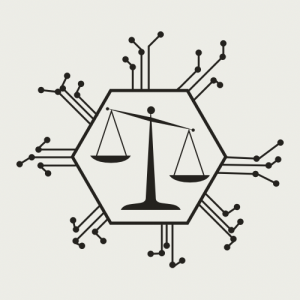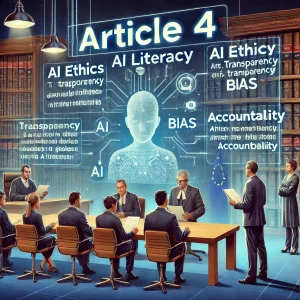Artificial intelligence isn´t just for sci-fi and nerdy engineers anymore – it´s a boardroom and courtroom topic. The European Union´s AI Act is the world´s first sweeping law on AI, and it packs an unexpected punch in Article 4: a mandate on AI literacy. Yes, you read that right – Brussels is effectively telling companies, “Teach your people about AI, or else”. In this in-depth (yet hopefully entertaining) analysis, we´ll break down what Article 4 requires, why it matters, how it compares to what other tech-savvy (and not-so-savvy) jurisdictions are doing, and the pros and cons of making AI literacy a legal must. Whether you´re new to AI law or an old pro, grab a coffee and let´s decode this new rule.
The Legal Lowdown: What Does Article 4 Actually Say?
Let´s unpack that in non-legalese:
- Who must do this? Providers (those who develop or put AI systems on the market) and deployers (those who use AI systems under their authority). In other words, both the makers and the users of AI in a professional context have homework to do. Notably, this applies regardless of the AI system´s risk level. Whether you´re deploying a high-risk medical diagnosis AI or just a cute customer service chatbot, the literacy duty sticks. By putting thins in Article 4 – right after definitions – the EU emphasized it as a foundational principal.
- What is “AI literacy”? The Act helpfully defines it in Article 3 (56). It means the “skills, knowledge and understanding” that let people “make an informed deployment of AI systems” and be aware of AI´s opportunities, risks and potential harms. Essentially, employees should know enough about AI to use it wisely – for example, to interpret AI outputs correctly and grasp how those outputs might impact individuals. Think of it as a baseline of AI street smarts in the workplace.
- What exactly must companies do? They must “take measures to ensure” sufficient AI literacy “to their best extend”. This phrasing implies a best-effort obligation, not an absolute guarantee. Companies have flexibility in how to comply – there´s no fixed curriculum mandated by law. Art. 4 explicitly says you should tailor training to your staff´s technical background and the context in which the AI is used. So, a startup´s engineers might need deep ML model training, whereas a bank´s call-center team might need simpler guidance on using an AI chatbot tool. The literacy level should also consider who the AI´s end-users or impacted persons are. For instance, if your AI will interact with vulnerable groups, you better ensure your staff knows the ethical and legal sensitivities involved.
- When does this kick in? It already has! The AI Act entered into force on 1st of August 2024, and Article 4´s literacy requirements are applicable from 2nd of February 2025. That date is circled in many compliance officer´s calendars. It´s one of the first provisions to apply, even before the bulk of high-risk AI rules. The EU gave roughly six months lead time, basically telling organizations: “New year, new you – get your AI training programs ready by Feb. 2025”.
- Enforcement and scope: This requirement has extra-territorial reach- Non-EU companies providing or using AI in the EU market also must comply. Regulators could ask for proof of training efforts, and non-compliance can lead to penalties (the AI Act´s fines can exceed GDPR fines in theory). However, because the obligation is high-level, enforcement will likely focus on blatant failures (like doing nothing at all). If you at least did something – e.g. provided a training module or policy – you have some defense. One law firm wryly noted that if you ignore4 and skip training entirely, you´ll face an uphill battle explaining yourself, whereas making a reasonable effort should “make defending against regulators or civil claimants much easier”. In short: doing zero is asking for trouble, doing something is your safety net.
Recital context: The Act´s recital (those “whereas” clauses that set context) reinforce why AI literacy is needed. Recital 20 emphasizes that widespread AI literacy gives all AI value-chain players the insight to ensure proper compliance and enforcement of the law. It even suggests that rolling out AI literacy measures (with follow-ups) could help improve trust and oversight in AI. The EU is so serious about this that it tasks the future European AI Board to promote AI literacy tools and public awareness about AI´s benefits, risks, and rights. The Commission and Member States are encouraging to support voluntary codes of conduct to advance AI literacy among those developing, operating, or using AI. In EU policymaker speak, that´s a big “everyone needs to get educated on AI, PRONTO!”
Real-World AI Literacy Woes: Why Did This Become Law?
You might wonder, why legislate something as touchy as literacy? Well, reality is stranger than fiction – or at least as strange – when people deploy AI without understanding it. Here are a few cautionary tales and challenges from the real world that likely inspired the EU´s move:
Automation Over-Reliance:
In fields like transportation and healthcare, we´ve seen that when users over-trust AI without understanding its limitations, the results can be fatal. Think of drivers who treated Tesla´s Autopilot as a full self-driving system and took a nap with tragic crashes as a result. Investigations often find the human either wasn´t paying attention or overestimated the AI´s capabilities. AI literacy in this context means knowing the difference between “driver assistance” and “driver replacement”. Similarly, doctors using diagnostic AI need to know it´s an assistant, not an omniscient oracle. For example, if an AU suggests a diagnosis or treatment, medical staff should understand how to interpret that suggestion and double-check critical decisions. This human-AI interaction nuance is part of AI literacy – knowing when to trust and when to question the machine.
Biased AI and Unintended Discrimination:
A few years ago, a certain big tech company scrapped an AI recruiting tool that turned out to be biased against women. The hiring team didn´t realize the model was trained on past data that reflected a male-heavy workforce, so the AI learned to prefer male candidates. Oops. If the team had more AI literacy, they might have spotted the risk or at least tested for bias sooner. A “sufficient level of AI literacy” means understanding concepts like algorithmic bias, fairness, and the need for diverse training data. Without that, well-meaning staff might inadvertently deploy sexist, racist, or otherwise problematic AI systems – and only learn of the bias after harm is done. (No company wants the PR nightmare of “Our AI is prejudiced” headlines.)
In short, the EU lawmakers have seen one too many episodes of “When AI goes Wrong” caused by human misunderstanding. Article 4 is their way of saying: most AI failures are human failures – so let´s educate humans. It´s a proactive approach, trying to prevent fiascos by raising baseline competence. Of course, implementing this is easier said than done (more on those challenges later).


How Does This Compare Globally (Spoiler: The EU is the Strict Schoolmarm)
So, Europe is making AI literacy a legal requirement. What about other tech superpowers and frameworks? Let´s take a quick world tour:
United States:
The US hasn´t (yet) mandated AI literacy across the board, but the idea is catching on. Several draft bills in Congress suggest Americans don´t want to be left totally behind on the AI knowledge curve:
- The proposed AI Leadership Training Act would require the U.S. Office of Personal Management to implement annual AI training for federal employees in certain roles
- Meanwhile, an Artificial Intelligence Literacy Act of 2023 was introduced to beef up digital equity programs with AI literacy. The idea is to fund grants for training communities and workers on AI basics, recognizing that understanding AI is part of bridging the digital divide. This bill even defines AI literacy in a similar vein to the EU – as the ability to grasp AI´s principals, implications and ethical considerations. Again, it´s not law yet, just a reflection that U.S. policymakers see AI literacy as important.
Outside these bills, the U.S. approach to AI governance is mostly through guidelines and frameworks rather than hard law. Companies like Microsoft, Google, etc. often have internal AI ethics training programs (mostly voluntary, for now). In the absence of an “AI Act” in the U.S., many organizations are doing their own literacy efforts to avoid PR disasters and prep for possible future regulations. But as of 2024, there´s no federal law saying “thou shalt train thy staff on AI”. (Give it time – if more AI-related mishaps occur, Congress might get less shy.)
China:
When it comes to companies, Chinese regulations require internal governance for AI, but in a more rigid way. For example, China´s regulations on algorithmic recommendations (effective 2022) and generative AI (effective 2023) require companies to set up oversight mechanisms and ensure content moderation. Companies must appoint responsible personnel for algorithm safety and adhere to state-prescribed ethical norms, but there isn´t an explicit clause saying “train your staff on AI”. It´s more implicit. Given China´s governance style, an underperforming AI or a big mistake (like an app that produces banned content due to an engineer´s ignorance) can lead to swift regulatory action or even personal liability for company executives. So you can bet Chinese companies are training their AI teams – but it´s driven by fear of government crackdowns and licensing requirements, rather than a literacy principal per se.
One could say China´s de facto AI literacy program is “make everyone memorize the rulebook”. In fact, China is pouring resources into AI education at all levels (from AI courses in schools to Communist Party cadres learning about AI), aligning with its national strategy to be an AI leader. But unlike the EU, this isn´t phrased as giving employees a right to be trained – it´s about ensuring the tech is controlled and aligns with state goals.
United Kingdom:
The UK, post-Brexit, is charting its own AI regulatory path. It has explicitly decided not to copy the EU AI Act wholesale, favoring a lighter, sector-based approach (at least for now). AI literacy isn’t a legal requirement in the UK – the government’s AI regulation policy papers have mentioned the importance of educating AI users, but there’s no Article 4 equivalent coming into force. For example, responses to the UK’s AI regulation consultation highlighted AI literacy as important, and they drew analogies to other domains (like media literacy duties under online safety laws). But the UK decided not to impose mandatory training via a single AI law.
That said, the UK is nudging towards AI education through other means. The government’s National AI Strategy and upcoming AI Action Plan both emphasize skills and training in AI. In early 2024, the UK even released a Generative AI guidance for government with ten principles – including “you know what generative AI is and its limitations” and “you have the skills needed to build and use AI”. These are essentially AI literacy goals, but framed as best practices rather than binding rules. There’s also talk of creating AI Officers in organizations under a proposed AI Regulation Bill (draft) who might oversee such training, but again, nothing concrete enacted yet. So, in cheeky terms: the UK is saying “AI literacy is jolly important, old chap,” but stopping short of making it law.
Other Frameworks (OECD, etc.):
On the international stage, the OECD AI Principles (endorsed by many countries, including the US and EU members) stress investing in people and skills for trustworthy AI. They encourage training programs and public awareness so that AI benefits society. UNESCO’s Recommendation on AI Ethics (2021) also highlights education and capacity-building as key for AI governance. These global frameworks all sing the same tune: people need to understand AI better. However, they rely on member countries to implement that. The EU answered the call with Article 4; others are mostly in aspirational or planning phases.
Bottom line: The EU is currently the strict schoolmarm forcing everyone to attend AI class by law. The US is experimenting with voluntary classes and a few draft “please study” notes. China is running a national campaign to ensure everyone and their grandma knows about AI (with Chinese characteristics), though companies mainly worry about complying with government rules. And the UK is politely suggesting folks mind the AI gap. As AI systems proliferate, don’t be surprised if more jurisdictions move from suggestions to requirements – nobody wants uneducated AI users causing chaos.
Pros and Cons of Mandating AI Literacy
Is Article 4 brilliant stroke of proactive governance, or an overbearing rule that’s hard to enforce? Yes. (Just kidding – let’s analyze.)
👍 Pros (The Good and the Promising):
Better AI Outcomes and Fewer Fiascos:
Knowledge is power. Training staff on AI’s workings and pitfalls should reduce oops moments. Employees who know AI can be biased or fallible will test it more carefully. They’ll be less likely to blindly follow a robo-advisor off a cliff. This means safer products and services for consumers. The EU lawmakers believe this will “ensure appropriate compliance and correct enforcement” of the AI Act itself – essentially, educated staff are the first line of defense against lawbreaking AI deployments.
Empowered & Trustworthy Workforce:
In an AI-driven world, companies with AI-literate employees might be more competitive. Instead of fearing AI, staff can leverage it smartly. Imagine a banker who understands an AI risk model enough to explain it to a skeptical client, or a doctor who can interpret an AI’s diagnosis and reassure a patient. AI literacy can foster trust: both internally (teams confident in using the tools) and externally (customers confident that someone competent is at the wheel). It’s like having a crew that not only has a fancy autopilot, but also knows how to fly the plane if needed.
Ethical and Responsible AI Culture:
Mandating training forces companies to have conversations about AI ethics, bias, privacy, etc. This can bake a culture of responsibility into the org. It’s similar to how mandatory data protection training under GDPR raised general awareness of privacy. When everyone from the CEO to the intern has to learn a bit about AI, it demystifies the tech. AI isn’t just the IT department’s problem – it’s everyone’s business. Over time, this could lead to more thoughtful AI design and deployment. Article 4 also explicitly connects to fundamental rights – staff should be aware of potential harms to people. That’s a nudge toward ethical mindfulness.
Harmonization and Minimum Standard:
By making it law, the EU sets a baseline across the single market. This avoids a patchwork where some companies do heavy AI training and others do zilch. If everyone has to do something, the overall “AI IQ” should rise. It’s akin to requiring a driver’s license – you know all drivers at least learned the rules of the road (even if some still drive like maniacs). In theory, this makes cross-border operations easier: an employee of a French company transferred to its German branch will find a similar approach to AI literacy there.
👎 Cons (The Challenges and the Skepticism):
Vagueness and Compliance Uncertainty:
What exactly is “sufficient” AI literacy and “to their best extent” effort? 🤷 Nobody knows for sure – not even the regulators, until they start enforcing. Companies might wring their hands over questions like: How many hours of training are enough? Do we need to test employees? What if one division is fully trained and another isn’t – are we in breach? The open-endedness, while flexible, also breeds uncertainty. Each company must kind of guess what regulators (or courts) will deem acceptable if something goes wrong. Ambiguity in law can lead to inconsistent application or, worse, become a lawyers’ full-employment act when arguing if XYZ company met the standard.
One More Box to Tick?
The cynical view: Some companies will treat this as just a compliance checkbox, rolling out perfunctory online training that employees click through while half-asleep. Let’s face it, many workers joke about mandatory e-learning modules (“I scored 100% on the quiz by guessing!”). If AI literacy programs are done just to satisfy the law, they might not truly educate. There’s a risk of compliance theater – looking good on paper but not actually improving understanding. And if that happens, the whole purpose of Article 4 is undermined. Regulators might then push for more specific rules, creating a spiral of more red tape.
Burden on Businesses (Especially the Little Guys):
Designing and delivering AI training takes resources – time, money, expertise. Big tech firms likely already have AI 101 courses internally. But a small or mid-sized company that just buys some AI software might struggle. They’ll ask, “Do we now need to hire an AI consultant or send our team to AI bootcamp?” For startups, this could be a distraction from their core work or an extra cost they hadn’t budgeted. The AI Act does have some consideration for SMEs in other articles, but Article 4 applies broadly. There’s a concern it could marginally slow AI adoption by smaller firms – they might think twice about using an AI system if they also have to train staff for it. (Of course, ignorance might cost more in the long run if something goes awry – but short-termism is a thing.)
Measuring Effectiveness is Hard:
How do we know if an organization truly achieved “AI literacy” for its people? There’s no ISO standard or exam for this (yet). If an incident occurs – say, an employee misuses AI causing harm – will that be proof the training was insufficient? Possibly, but not necessarily; even well-trained folks can slip up. Conversely, if a company has zero incidents, was it thanks to great training or just luck? Regulators might ask for documentation: training materials, attendance logs, etc., as a proxy. But quantity of training ≠ quality of understanding. This makes enforcement tricky. We might see divergent approaches, with some regulators issuing guidance on what they expect (number of hours, topics to cover) – which ironically would transform a flexible rule into something more prescriptive over time.
Scope Creep and Overload:
Today it’s AI literacy, tomorrow it could be AI driver’s licenses or certified AI ethics officers. As AI evolves (hello, general AI?), the knowledge required also shifts. Companies could find themselves in perpetual training mode, updating courses every year to cover the latest risks (deepfakes, new regulations, whatever’s next). Keeping training content fresh and relevant is a challenge. Also, not every employee needs an AI PhD’s level of detail – too much info can be overwhelming or irrelevant to someone’s job. Striking the right balance (not overshooting or undershooting) is more art than science.

Practical Implementation Challenges:
Implementing Article 4 will have some very real practical bumps in the road:
Identifying Who Needs Training:
The law says “staff and other persons…dealing with the operation and use” of AI. That clearly covers your data scientists and ML engineers. But what about the sales team that sells an AI-powered product? The marketing team writing content about it? The HR team using an AI recruiting tool (even if just off-the-shelf)? Likely yes to all. Companies must scope out who counts as an “AI user/operator” in their context – which might end up including a large chunk of the workforce these days. Also, do contractors count as “other persons…on their behalf”? Probably yes, if, say, you outsource AI development or have temps labeling data. Those folks may need training too (and you might have to demand the contracting firm provide it).
Developing Curriculum and Finding Teachers:
Many firms will ask, can we buy a solution for this? Cue the emerging market of “AI literacy training services.” There are already consultancies and online courses tailored to Article 4 compliance. Some industry groups might create standard training modules. Larger companies might develop in-house programs tapping their AI experts. But ensuring the content is both accessible (so non-techies can grasp it) and comprehensive (covering technical, ethical, legal aspects) is non-trivial. You’ll need examples, maybe interactive demos, and perhaps different tracks for different roles. It’s a whole new L&D (learning & development) challenge. At least the EU is aware of this need – the newly formed EU AI Office has set up a repository of AI literacy best practices to help organizations share ideas. So, one solution: copy homework from that repository (legally, of course!).
Documentation and Follow-up:
Simply running a training session isn’t enough – companies should document attendance/completion, have materials available for reference, and possibly refresh the training periodically. One-and-done might not fly if your AI usage evolves. Also, language and localization matter in the EU’s diverse landscape. Training might need to be in multiple languages or adjusted for cultural context. (An AI joke that lands in Ireland might confuse folks in Italy, for example. Trust me, I’ve bombed enough multilingual AI jokes to know.)
Despite these challenges, many experts see Article 4 as a net positive. It’s a nudge (or shove) that forces organizations to confront the “people side” of AI, not just the tech and compliance checklists. In that sense, it could save companies from themselves by preventing costly mistakes.
Final Thoughts

Article 4 of the EU AI Act may sound like a dry requirement, but it embodies a forward-thinking idea: in a world where AI is everywhere, humans are the ultimate wild card. You can have the fanciest algorithms and the strictest regulations, but if Bob in accounting still thinks ChatGPT is a sentient genius that can do his work with no oversight, you’re in trouble. The EU’s answer is to legislate common sense – to ensure Bob (and all his colleagues) get a clue about AI.
I believe that only in the future will we truly see and understand whether the vague and imprecise wording of Article 4 will lead to success. Moreover, it remains exciting to observe how companies will interpret this ambiguous wording and what solutions they will come up with.
From a legal standpoint, Article 4 breaks new ground by hard-coding “AI education” into compliance. Other jurisdictions are watching closely. Will Europe’s grand experiment create a more competent AI-using workforce and reduce AI failures? Or will it become another bureaucratic hoop with mixed results? The likely outcome lies somewhere in between, heavily depending on how organizations implement it. The savviest companies will approach AI literacy not just as a duty, but as an opportunity – to upskill staff, foster innovation, and build trust with clients and regulators alike. The less enthusiastic may do the bare minimum, potentially paying the price later when an untrained employee mishandles an AI system.
For newcomers to AI law: don’t be intimidated! At its heart, Article 4 is about people understanding what the heck they’re doing with AI. And for the experts: it’s a fascinating intersection of law, technology, and education policy – perhaps even a test of whether softer governance (training, culture) can mitigate risks better than just banning or strictly controlling tech.
One can’t help but chuckle that the EU effectively made a homework assignment for every AI user in Europe. It’s a bit like a teacher saying “class, there will be a test on this.” But given the stakes – AI impacting hiring decisions, driving cars, diagnosing diseases, even writing legal briefs – maybe a little pop quiz is warranted. As we compliance nerds often say: ignorance of the law is no excuse, and soon, ignorance of AI won’t be either (at least not in the EU).
So, here’s to AI literacy: may your staff be ever knowledgeable, your AI ever reliable, and your regulators pleasantly bored because nothing went wrong. In the wise words printed probably on some compliance officer’s coffee mug somewhere: “Trust in AI, but tie up your bias (with training).”
Stay curious, stay informed, and let´s keep exploring the fascinating world of AI together.
This post was written with the help of different AI tools.
Recommended Read
Disclaimer: The links provided on this blog lead to external websites that are not under my control. I do not guarantee the accuracy, or the content of those sites. Visiting these sites is at your own discretion and risk.
Article: AI literacy on the agenda by scl.org




